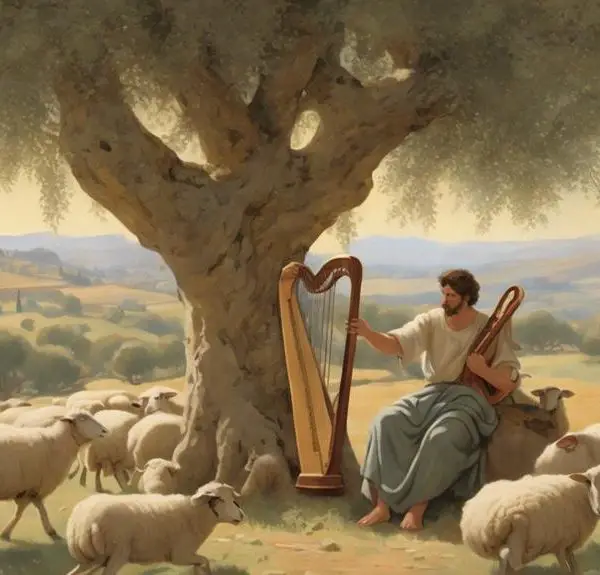Explore the deep symbolism of 'mote' in the Bible, uncovering lessons on judgment and self-awareness that transcend time.

What Does Mote Mean in the Bible
You might wonder if the concept of a 'mote' in the Bible carries more depth than its surface meaning suggests.
At its core, 'mote' refers to a tiny speck or flaw, often overlooked until pointed out. Its appearance in biblical texts, particularly in the context of the Mote and Beam parable, opens a doorway to profound ethical lessons and self-reflection.
The symbolism wrapped in this seemingly simple term may challenge your understanding of judgment, self-awareness, and compassion.
Imagine what insights lie hidden within these ancient teachings, waiting to be uncovered and applied to modern life.
Key Takeaways
- 'Mote' in the Bible symbolizes minor faults and human tendencies to judge others.
- Its interpretation varies across translations, impacting the depth of biblical understanding.
- The Mote and Beam Parable emphasizes self-reflection and personal accountability.
- Understanding 'mote' offers insights into ethics, humility, and the importance of compassion in society.
Definition of Mote

In an exploration of biblical terminology, 'mote' refers to a small speck or particle, often used metaphorically to denote a minor flaw or sin. Delving deeper, you'll find that the term's usage is heavily influenced by its linguistic roots and the variations in translations across different versions of the Bible. The origin of 'mote' is deeply entrenched in ancient languages, primarily Greek and Hebrew, from which the Bible was originally translated. The precision of these translations into English and other languages has significantly impacted the interpretation and understanding of biblical texts.
Understanding the term 'mote' in the Bible requires a scholarly analysis of language origins. The Greek word 'karphos', used in the New Testament, directly translates to a tiny piece of straw or wood, embodying the concept of something negligible yet visible. Similarly, in Hebrew, there are terms with analogous meanings, underscoring the widespread cultural recognition of the metaphorical value of minute, seemingly insignificant objects.
Translation variations play a pivotal role in how 'mote' is perceived in modern readings of biblical passages. Different versions of the Bible may use synonyms such as 'speck' or 'twig', each carrying slightly varied connotations. These variations stem from the translators' interpretations of ancient texts, their contextual understanding, and the linguistic nuances of the target language. The challenge lies in preserving the metaphorical essence of 'mote' while ensuring the translation's fidelity to the original text.
Analyzing 'mote' through the lenses of language origins and translation variations unveils the complexity and depth of biblical terminology. It highlights the meticulous care required in translating sacred texts, ensuring they resonate with contemporary readers while retaining their profound, intended meanings.
Biblical Context and Usage

Delving into biblical texts, one discovers that 'mote' frequently symbolizes minor faults or imperfections, offering profound insights into human character and morality. This term's usage in scripture, particularly in parables and teachings, showcases an astute observation of human nature and its tendencies towards hypocrisy and judgment. Through historical linguistics, one can trace the evolution of 'mote' and understand its significance in ancient contexts. This exploration reveals the nuanced ways in which language shapes and reflects the moral lessons imparted through biblical narratives.
The analysis of 'mote' within biblical passages necessitates a consideration of cultural variations and the historical backdrop against which these texts were written. The term's appearance in scripture often serves as a mirror, reflecting the societal norms and values of the time. It conveys a universal message about the dangers of overlooking one's flaws while criticizing others', a concept that transcends specific historical or cultural contexts.
Symbolism and Interpretation

Exploring the symbolism and interpretation of 'mote' within biblical texts reveals layers of meaning that profoundly impact understanding of self and others. This term, rooted in ancient languages, carries with it a rich tapestry of cultural significance and linguistic evolution, shaping its interpretation across centuries. The symbolism attached to 'mote' in the scriptures isn't just a matter of historical curiosity but serves as a mirror reflecting human nature, societal norms, and the evolving understanding of moral and ethical conduct.
To dive deeper into its significance, consider the following aspects:
- *Cultural significance:* The term 'mote' holds a place in the lexicon of ancient societies that were closely tied to their religious texts. Its usage and interpretation can tell us much about the values, beliefs, and daily realities of these communities.
- *Linguistic evolution:* The journey of the word 'mote' from its ancient roots to its current understanding showcases the dynamic nature of language and how it adapts to convey complex concepts and moral lessons.
- *Symbolic interpretations:* Within the biblical narrative, 'mote' serves as a symbol for minor faults or imperfections, offering a lens through which to examine human frailty and the tendency towards judgment and hypocrisy.
Through an analytical and scholarly exploration of these elements, you gain insight into not only the term itself but also the broader themes of human behavior and moral responsibility that it encapsulates. Understanding 'mote' in its biblical context opens up pathways to deeper reflections on self-awareness and the interplay between personal and collective ethics.
Mote and Beam Parable

Addressing the Mote and Beam Parable invites you to consider the profound lesson on self-awareness and judgment it imparts within the biblical context. This narrative, found in the Gospel according to Matthew, serves as a compelling visual metaphor that underscores the perils of judgment hypocrisy. It illustrates the folly of focusing on minor faults in others (the 'mote' in your brother's eye) while ignoring one's own significant shortcomings (the 'beam' in your own eye).
The parable employs hyperbole to emphasize its message, drawing a vivid picture of the absurdity inherent in criticizing others without introspection. This exaggerated comparison not only highlights the discrepancy in severity between the mote and beam but also points to a common human tendency to overlook one's own flaws while magnifying those of others.
In analyzing this parable, it's crucial to understand the cultural and historical context in which it was delivered. The metaphor of the mote and beam would have been readily understood by the original audience, conveying a clear and impactful message about the importance of humility and self-examination in moral and spiritual life.
Furthermore, this parable isn't merely about individual failings in judgment but also serves as a critique of societal and religious leaders who were quick to condemn others without reflecting on their own conduct. Thus, the Mote and Beam Parable encapsulates a timeless warning against the dangers of hypocrisy in judgment, inviting a deeper reflection on the ethics of critique and the necessity of personal accountability in moral discernment.
Ethical Lessons for Believers

Building on the Mote and Beam Parable's insights, it's crucial for believers to examine the ethical lessons that underscore the importance of practicing self-reflection and humility in judgment. This timeless parable, by emphasizing the folly of criticizing others while ignoring one's own faults, serves as a potent tool for personal growth and ethical conduct. The principle of personal accountability is at the heart of this lesson, urging you to introspect before casting judgment. This approach not only fosters individual moral development but also contributes to a more empathetic and understanding society.
Understanding the parable's ethical implications involves considering several key points:
- Personal Accountability: Recognizing and addressing your own shortcomings before scrutinizing others is vital. This self-awareness leads to personal growth and reduces the likelihood of unfair criticism.
- Humility in Judgment: Adopting a humble approach when evaluating others' actions or behaviors is essential. Understanding that everyone has their own struggles encourages compassion rather than judgment.
- Impact on Societal Judgment: By focusing on self-improvement and empathy, the collective mindset shifts from one of judgment to understanding, promoting a more inclusive and supportive community.
The Mote and Beam Parable, therefore, not only challenges you to reflect on your actions and attitudes but also calls for a reassessment of societal judgment norms. By internalizing these lessons, you can contribute to a society where personal accountability and mutual respect are paramount, paving the way for a more compassionate and ethical world.
Modern-Day Relevance

In today's rapidly evolving societal landscape, the Mote and Beam Parable's teachings on self-awareness and empathy hold significant relevance for addressing contemporary issues of judgment and moral accountability. As you navigate through a world increasingly defined by polarized opinions and cultural perceptions, the wisdom encapsulated in this biblical narrative serves as a timeless reminder of the importance of introspection before criticism.
The concept of the mote, symbolizing minor faults in others, juxtaposed with the beam, representing one's own larger flaws, critically underscores the necessity of personal accountability in the modern context. In an era where social media platforms amplify the tendency to scrutinize and judge others without reflection, the parable's message urges you to consider your own imperfections before casting judgment. This principle, when applied, has the potential to foster a culture of understanding and compassion, rather than one of condemnation and divisiveness.
Moreover, this ancient teaching encourages you to challenge your own cultural perceptions and biases. By recognizing that what you often perceive as faults in others may be influenced by your own subjective viewpoints, you're invited to engage in a deeper level of empathy. This self-reflective practice not only enhances personal growth but also contributes to building more inclusive communities.
Frequently Asked Questions
How Has the Translation of the Word "Mote" Varied Across Different Versions of the Bible?
You're diving into how the translation of 'mote' has shifted across Bible versions, touching on translation challenges and linguistic evolution.
It's fascinating to see how scholars grapple with ancient texts, striving for accuracy while navigating the nuances of language change.
This exploration reveals the intricate process of translating sacred texts, where every word choice is deliberated, reflecting both linguistic shifts and evolving understanding of the original manuscripts.
It's a detailed, scholarly journey into the heart of biblical interpretation.
Are There Any Archaeological Findings or Historical Artifacts That Depict the "Mote and Beam" Parable Visually?
Ever wondered how ancient stories are visually captured?
When it comes to the 'mote and beam' parable, yes, there are archaeological finds and historical artifacts that offer a glimpse into how this parable was depicted.
These items showcase diverse visual interpretation strategies, reflecting the era's artistic norms.
Artifact preservation methods play a crucial role in keeping these interpretations accessible, allowing us to analyze and appreciate the parable's enduring significance through time.
How Do Non-Christian Religious Texts or Traditions Interpret or Reference the Concept of a "Mote"?
In exploring mote symbolism across various non-Christian religious texts, you'll find a wealth of cultural interpretations. These traditions often equate the mote with minor flaws or imperfections, symbolizing a universal human condition.
In What Ways Have Famous Theologians Throughout History Disagreed on the Interpretation of the "Mote and Beam" Parable?
Throughout history, theologians have tussled with the 'mote and beam' parable, leading to diverse debates. Their disagreements delve deep into the theological implications and ethical interpretations of this parable.
You'll find that while some argue it emphasizes personal introspection over judgment, others believe it underscores broader societal critiques. This scholarly discourse sheds light on the multifaceted nature of biblical analysis, illustrating how interpretations evolve over time, reflecting changing contexts and values.
Can the Concept of the "Mote" Be Related to Psychological Phenomena, Such as Cognitive Biases or Perception Errors, According to Modern Psychology?
In modern psychology, you can relate the concept of 'mote' to cognitive biases and perception errors. Through the lens of perception theory, it's clear that biases often cloud judgment, similar to how a small mote might obscure vision.
Bias awareness is crucial in understanding these psychological phenomena. Analyzing this from a scholarly perspective, the analogy highlights how minor flaws in perception can significantly impact one's ability to see the bigger picture accurately.
Conclusion
In conclusion, you've seen how a mote, a tiny speck, becomes a powerful symbol in the Bible, particularly within the mote and beam parable. This imagery vividly illustrates the hypocrisy of judging others without self-reflection.
Isn't it remarkable how such a small word carries profound ethical lessons for believers? It challenges you to introspect and correct your own flaws before criticizing others. Indeed, its relevance today is undeniable, urging a journey towards personal improvement and empathy in our modern lives.



Sign up